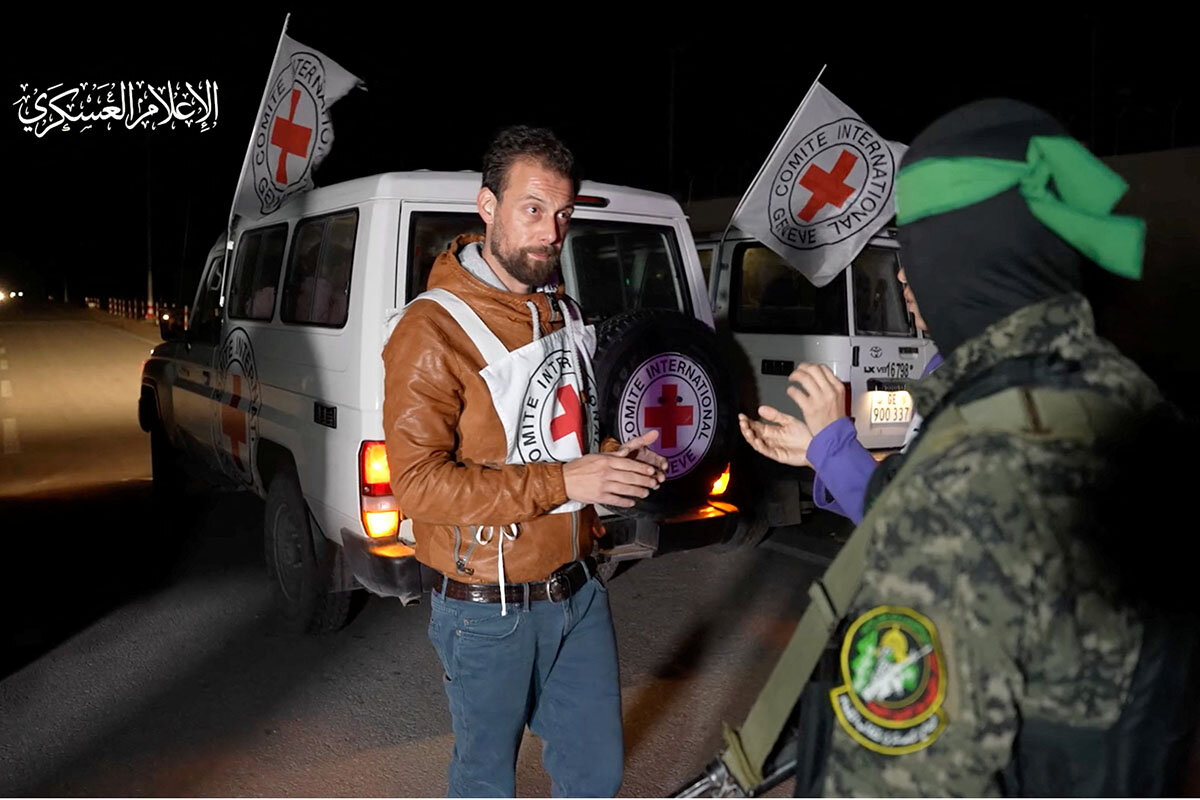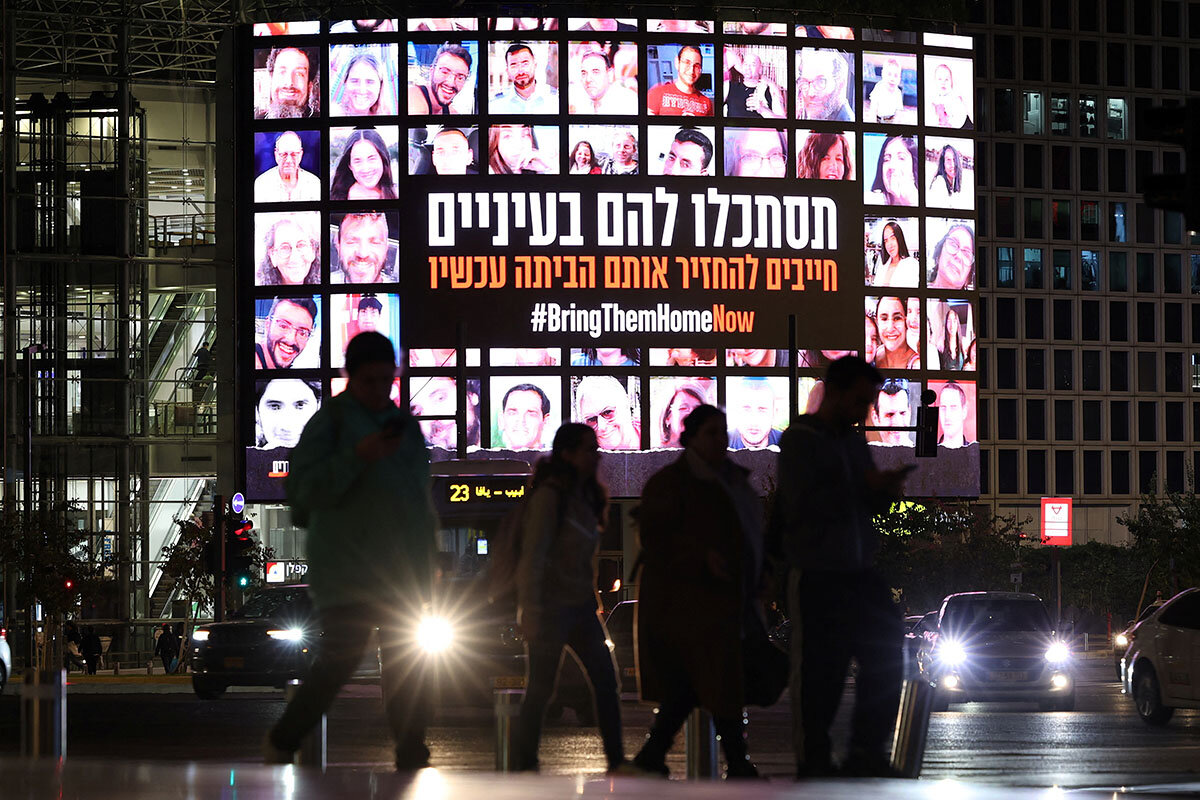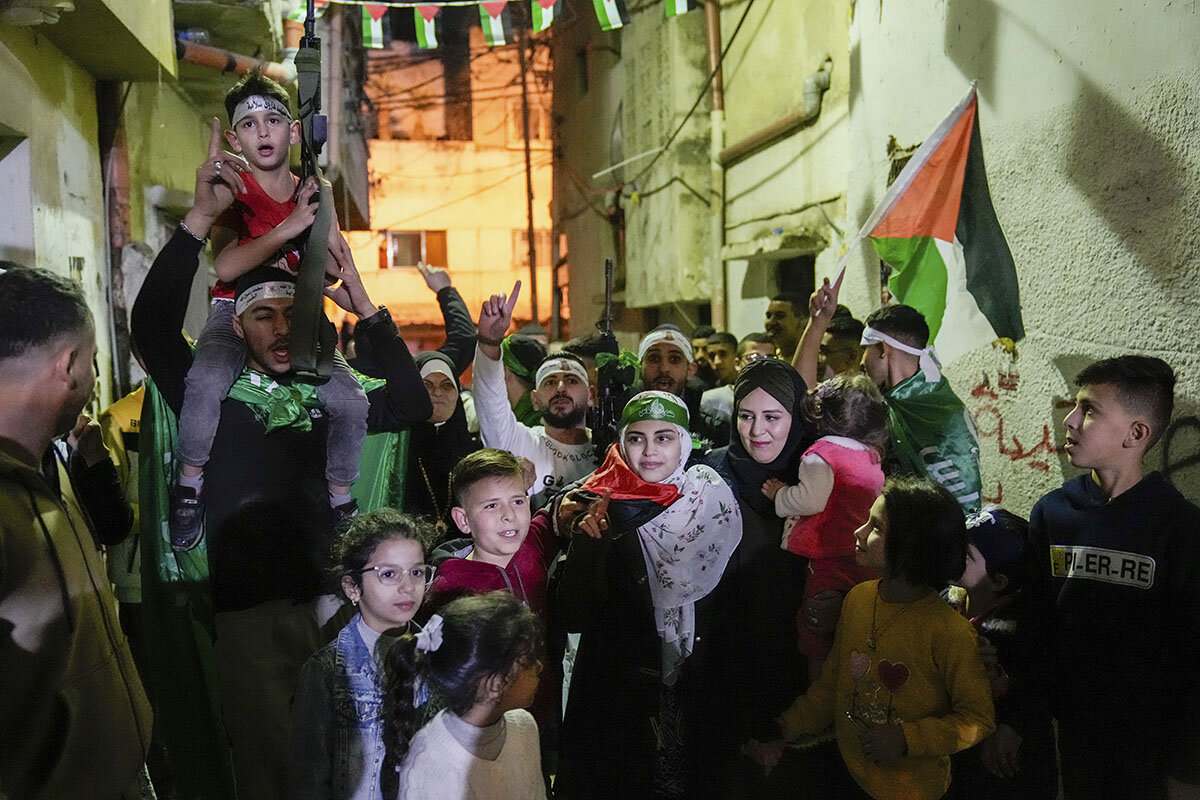Israel-Hamas: The harder hostage negotiations still to come
Loading...
| LONDON
Both Israelis and Palestinians have reveled in the results of the temporary cease-fire between Israel and Hamas in the Gaza Strip.
The initial pause in fighting paved the way for Hamas’ release of 50 civilian Israeli hostages in exchange for Israel’s freeing of 150 Palestinian security prisoners, leading to tearful scenes and jubilation on both sides. On Tuesday, a further 10 Israeli hostages and 30 Palestinian prisoners were released, preserving the agreed-upon 3-1 ratio.
Why We Wrote This
A story focused onVery soon, Israelis and Palestinians will run out of comparatively easy things to do to extend the cease-fire. Then, they’ll have to get to the hard things. How that goes will largely be determined by Israel, which faces pressure to resume fighting.
For both sides, the hostage deal has so far involved trading low-hanging fruit – the Israelis freed by Hamas, for example, include 3-year-old twin girls – but analysts say the point is swiftly approaching when the price demanded by one side or the other will become unacceptably high.
“There is a formula for civilians,” says Daniel Levy, president of the U.S./Middle East Project and a former Israeli negotiator. “But ... once it comes to soldiers ... it’s a different formula, so you need to renegotiate that.”
Gershon Baskin, an Israeli peace process adviser and hostage negotiator, says such a negotiation is all the more challenging for Israel, as it simultaneously tries to destroy Hamas militarily. That may be possible to achieve to a degree, he says, but any real solution must reach beyond the current crisis – and current leadership, on both sides – to a two-state solution to the Israeli-Palestinian conflict.
Both Israelis and Palestinians have reveled in the results of the temporary cease-fire between Israel and Hamas in the Gaza Strip.
In its initial four days, the pause in fighting paved the way for the release of 50 civilian Israeli hostages by Hamas, the militant group that rules Gaza, in exchange for the freeing of 150 Palestinian security prisoners by Israel.
The pause – so far extended by two days through Wednesday – has led to tearful scenes and moments of national elation in Israel, as the daily batches of freed women and children rejoined loved ones after seven weeks of Hamas captivity.
Why We Wrote This
A story focused onVery soon, Israelis and Palestinians will run out of comparatively easy things to do to extend the cease-fire. Then, they’ll have to get to the hard things. How that goes will largely be determined by Israel, which faces pressure to resume fighting.
There have also been daily scenes of public jubilation and flying of the green Hamas flag in the occupied West Bank, as Palestinian women and children – some incarcerated for stone-throwing or making knives – were reunited with their families.
On Tuesday, a further 10 Israeli hostages and 30 Palestinian prisoners were released, preserving the agreed-upon 3-1 ratio.
The original cease-fire deal – negotiated by Qatar and shepherded by the United States – paused the Israeli military offensive in Gaza that seeks to “destroy” Hamas following its Oct. 7 attack on Israel, which left 1,200 people dead and 240 captured and shook the Jewish state to its core.
More than 13,000 people have been killed in Gaza, including thousands of children, in the Israeli offensive, and Israeli leaders have vowed to resume the military campaign when the cease-fire expires. High-level talks are continuing in Qatar to extend the pause.
For both sides, the hostage deal has so far involved trading low-hanging fruit – the Israelis freed by Hamas, for example, include 3-year-old twin girls – but analysts say the point is swiftly approaching when the price demanded by one side or the other will become unacceptably high.
“We are running out of road very quickly, even if we get extensions, on this format,” says Daniel Levy, president of the U.S./Middle East Project and a former Israeli negotiator with the Palestinians under former Prime Ministers Ehud Barak and Yitzhak Rabin.
“There is a formula for civilians, for women, children, elderly, and the unwell, and that formula can go a fair bit further,” says Mr. Levy. “But ... once it comes to soldiers and fighting-age males – the majority of whom would be considered reservists – it’s a different formula, so you need to renegotiate that.
“But you also can’t negotiate that out of the context of what is the broader end to this phase of hostilities,” he says. “Let’s put it bluntly: Hamas is not going to give up the soldiers, and not get close to giving up everyone who is not a soldier, until they have a much better prisoner offer on the table – and parameters for ending the overall campaign.
“Why would they [Hamas] give up the last ones, without something that looks like a guarantee that Israel can’t continue doing what it’s doing now indefinitely?” asks Mr. Levy.
For Hamas, Israel’s stated war aims and Hamas’ finite number of hostages to use as bargaining chips will almost certainly raise the price of captured Israeli soldiers. Hamas leaders have spoken of an “all-for-all” exchange of all hostages for the release of all Palestinian prisoners, who now number some 7,200 – a step no Israeli government has ever taken.
And for Israel, waiting for an uncertain outcome of hostage releases means delaying momentum of its war, while under increased pressure from the U.S. and other nations to ease the conflict. It also means ultimately being forced to decide if the bid to destroy Hamas outweighs the lives of scores or more of Israelis who might not yet be free.
Releasing all Palestinians is “really a nonstarter for Israel,” says Gershon Baskin, an Israeli peace process adviser and negotiator who was instrumental in the 2011 release of Israeli soldier Gilad Shalit, who spent five years in Hamas captivity. In that deal, more than 1,000 Palestinians were released from prison, including Yahya Sinwar – the current leader of Hamas in Gaza and architect of the Oct. 7 attack.
“The red line over the last eight years has been prisoners with blood on their hands, prisoners who have killed Israelis. And looking back on the Shalit deal, I think there are people in the government who will hold fast to that,” says Mr. Baskin, author of “The Negotiator: Freeing Gilad Schalit From Hamas.”
“Sinwar is going to start by demanding the prisoners who have served the most time, who are prisoners who have killed Israelis,” says Mr. Baskin.
“His gold standard is what he said on the day he was released from prison [in 2011], and has said in every speech since, that he will empty the Israeli prisons. That’s his goal.
“Forget the numbers,” Mr. Baskin says. “If it were 300 prisoners, it would be the same thing. But there are 7,200 prisoners; his goal is to release every single Palestinian prisoner.”
Such a negotiation is all the more challenging for Israel, as it simultaneously tries to destroy Hamas militarily. That war aim may be possible to achieve to a degree, says Mr. Baskin, but any real solution must reach beyond the current crisis – and current leadership, on both sides – to a two-state solution to the Israeli-Palestinian conflict.
“You can’t destroy Hamas as an idea with weapons,” he says. “For that you need a better idea, which has to be a genuine peace process, the establishment of the state of Palestine, the recognition of the state of Palestine, massive international engagement involved in rebuilding Gaza and lifting the Palestinian economy. Forcing Israel to end the occupation.
“Those are the ideas that beat Hamas,” says Mr. Baskin.
“So the question is: Is [the peace process] going to be genuine?” asks Mr. Baskin. “And what are the mechanisms that are going to demonstrate that each side is fighting its own internal insurgents against peace? No one can be sure 100% of peace, but it really depends on the effort being made.”
And getting to that point may depend on the results of Israel’s deeper sweep into Gaza, and of any further cease-fire extensions. After ordering Gaza residents weeks ago to leave the north of the strip for the south for their own safety, Israeli forces have now dropped leaflets on the southern city of Khan Yunis, asking Palestinians to leave again.
“I genuinely don’t think it is so difficult on the Hamas side, because in no small measure they have won already. If this ended tomorrow, [for Hamas] what’s not to like?” says Mr. Levy of the U.S./Middle East Project.
“So I think the real sticking point is on the Israeli side: Under what circumstances, what level of pressure, internal and external, can the Israeli leadership ... be talked down from, ‘We are going to carry on for as long as it takes,’ and going into Khan Yunis and southern Gaza?” asks Mr. Levy.
“I just don’t see how that happens,” he adds, “without some combination of an even stronger domestic push that is led by the families of the missing, that got us to this moment – we should be under no illusions that, if it weren’t for the public pressure of the families, this pause wouldn’t have happened – and of course American pressure that this has to be brought to an end.”











